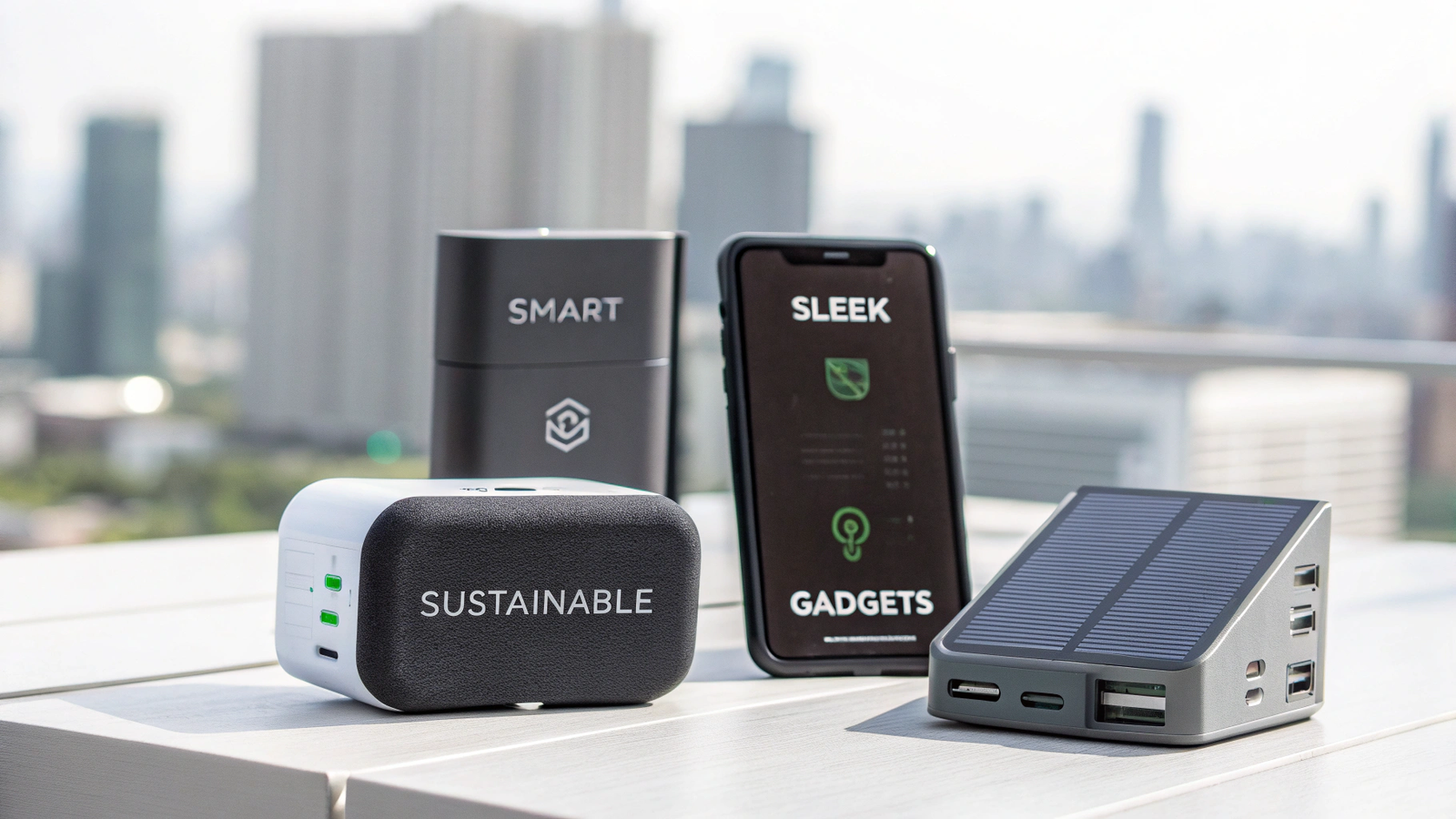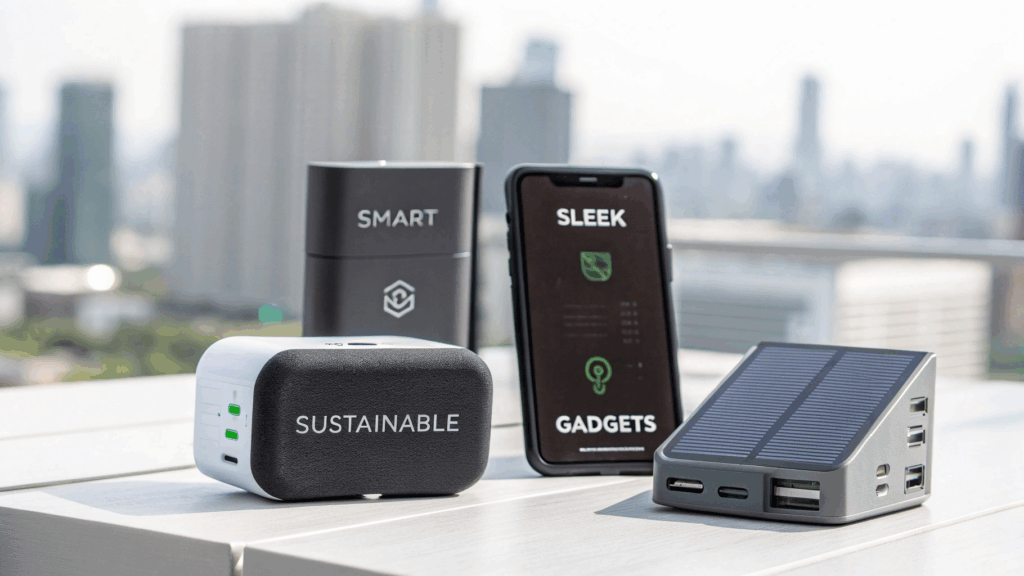
Smart, Sleek, and Sustainable: Gadgets for a Greener Tomorrow
Introduction
The 21st century is an age defined by innovation. Our homes, workplaces, and lifestyles are powered by sleek, intelligent devices that once belonged only in science fiction. But as technology evolves, so do the challenges we face—especially those tied to environmental degradation. The more connected we become, the greater the demand for energy, rare earth elements, and short product life cycles, leading to massive electronic waste and resource depletion.
In response to these concerns, a new wave of innovation is emerging: smart, sleek, and sustainable gadgets that aim not only to serve our digital needs but also to help safeguard the planet. These devices don’t just boast cutting-edge performance and minimalist aesthetics—they are designed to minimize ecological footprints, maximize energy efficiency, and last longer through modularity and repairability.
This article explores the technologies, philosophies, and consumer behaviors driving the shift toward greener gadgets, showcasing how sustainability is reshaping the future of consumer electronics.

1. The Need for Sustainable Tech
The Environmental Cost of Modern Gadgets
Each smartphone, laptop, and smart home hub leaves behind a significant ecological footprint. According to the Global E-Waste Monitor 2020, the world produced 53.6 million metric tons of e-waste in 2019, a number expected to reach over 74 million metric tons by 2030.
The production of a single smartphone requires:
- Over 70 different elements, including gold, lithium, and cobalt—many of which are mined under environmentally destructive and ethically questionable conditions.
- Approximately 50 kg of carbon emissions, primarily due to mining, production, and logistics.
Given the rapid turnover rate of consumer electronics, the environmental burden is unsustainable.
The Shift Toward Green Consumerism
Today’s consumers are more eco-aware. Surveys show that 73% of millennials and 66% of Gen Z consider sustainability when making purchases. Tech companies are responding with a new generation of products that are intelligent, beautiful, and planet-friendly—the embodiment of “smart, sleek, and sustainable.”
2. Sustainable Materials: From Waste to Wonder
The use of sustainable materials in gadget design is gaining momentum, transforming waste into high-performance, stylish products.
Recycled and Upcycled Materials
Many manufacturers are turning to recycled plastics, metals, and rare earth elements in their products:
- HP incorporates ocean-bound plastics into its laptops and monitors.
- Apple’s MacBooks and iPhones now use 100% recycled aluminum enclosures.
- Dell uses reclaimed carbon fiber and closed-loop recycled gold in motherboards.
By doing so, companies reduce the need for virgin material extraction and lessen the environmental impact of mining and manufacturing.
Natural and Biodegradable Components
Designers are also experimenting with biodegradable and renewable materials, such as:
- Bamboo for phone cases and speakers
- Cork and flax fibers in headphones and accessories
- Bioplastics made from cornstarch or algae
These materials align with growing consumer interest in products that are both aesthetically pleasing and compostable at end-of-life.
3. Modularity and the Right to Repair
One of the most transformative shifts in sustainable gadget design is the emphasis on modularity and repairability, empowering users to upgrade or replace parts rather than discarding entire devices.
Fairphone: A Flagbearer of Modularity
The Fairphone 5 is perhaps the most famous modular smartphone. It allows users to replace the battery, display, and camera modules using a single screwdriver—no tech expertise needed. Fairphone’s transparent supply chain and ethical sourcing have made it a symbol of sustainability in the mobile tech space.
Framework Laptop
Another standout is the Framework Laptop, which features:
- Easily replaceable RAM, SSD, battery, and display
- Modular ports users can swap themselves
- An online marketplace for parts and upgrades
Such designs challenge the planned obsolescence model and contribute to a longer product lifecycle—one of the most powerful ways to reduce tech-related emissions.
4. Energy Efficiency: Powering Down the Footprint
Energy consumption remains a major environmental concern in gadget use. Fortunately, smart devices are getting much better at doing more with less energy.

Smart Energy Management
Gadgets like smart thermostats, plugs, and lighting systems reduce household energy waste:
- Nest Thermostat can cut heating and cooling costs by up to 20%.
- Smart plugs automatically turn off devices in standby mode, reducing phantom loads.
- LED smart bulbs consume up to 80% less energy than traditional lighting.
When scaled across millions of homes, these tools contribute significantly to energy conservation and carbon reduction.
Low-Power Chips and AI Optimization
Modern processors like Apple’s M-series chips, ARM-based SoCs, and Qualcomm Snapdragon are designed to balance high performance with low power consumption. Features like dynamic voltage scaling and AI-based task allocation help devices operate more efficiently—using only the energy needed.
In addition, machine learning algorithms optimize charging cycles and battery usage in smartphones and laptops, extending battery lifespan and reducing energy draw.
5. Renewable Energy Integration
Eco-conscious gadgets are increasingly designed to generate or utilize renewable energy.
Solar-Powered Devices
Solar technology is being integrated into a wide range of gadgets:
- Solar phone chargers and power banks provide off-grid energy solutions.
- Wearables like Garmin’s solar-powered smartwatches extend battery life significantly.
- Solar backpacks allow users to charge their phones and devices on the go.
For remote areas or users looking to reduce their dependence on grid power, solar-powered tech offers a practical and sustainable solution.
Energy-Harvesting Innovations
Researchers are developing energy-harvesting technologies that convert body heat, motion, or ambient radio waves into usable power:
- Thermoelectric wearables that charge with body heat
- Piezoelectric sensors that power themselves with movement
- RF energy scavengers that convert Wi-Fi and cellular signals into electricity
These innovations could one day enable self-sustaining gadgets, eliminating the need for batteries altogether.
6. Circular Economy: Closing the Loop
Sustainability in tech isn’t just about product design—it’s about ensuring devices have a second, third, or even fourth life.
Trade-In and Take-Back Programs
Major brands now operate take-back schemes for old gadgets:
- Apple’s Trade In program refurbishes returned iPhones and recycles unusable parts.
- Dell Reconnect allows users to drop off old tech for free recycling at Goodwill locations.
- Samsung runs Galaxy Upcycling, repurposing old phones as IoT devices.
These initiatives reduce e-waste and recapture valuable materials for reuse.
Refurbishment and Recommerce
The refurbished tech market is booming. Retailers now offer certified pre-owned phones, laptops, and tablets—often with warranties and discounts. This not only extends the life of devices but also reduces the demand for new resources and manufacturing emissions.
7. Smart Gadgets That Promote Eco-Friendly Living

Some of the smartest gadgets are those that encourage sustainable behavior.
Eco-Tracking Apps and Wearables
Apps and wearables now help users monitor and reduce their personal environmental impact:
- JouleBug, Oroeco, and My Earth track carbon footprints and offer daily green tips.
- Fitness wearables like Apple Watch and Fitbit integrate eco-activity tracking, like steps taken instead of driving.
Smart Appliances and Eco-Modes
Modern appliances now feature eco-modes that use less water and electricity:
- Energy Star-rated dishwashers and washers adjust cycles to reduce energy and water use.
- Smart fridges optimize temperature to minimize power draw and food spoilage.
Such smart functionality helps households make greener choices effortlessly.
8. Corporate Commitment to Green Innovation
Tech companies are playing a pivotal role in pushing green gadgets from concept to reality.
Sustainability Goals and Climate Pledges
- Apple aims to be carbon neutral across its entire supply chain by 2030.
- Microsoft plans to become carbon negative by 2030, including retroactive emissions removal.
- Google powers all operations with 100% renewable energy and designs its hardware with circular economy principles.
These efforts signal a shift from green marketing to genuine sustainability leadership.
Open Standards and Collaboration
Organizations like the Green Electronics Council and initiatives such as TCO Certified and EPEAT are helping standardize and promote sustainable tech practices across industries.
9. Challenges on the Road Ahead
Despite the momentum, significant barriers remain:
Cost and Accessibility
Eco-friendly gadgets often carry higher price tags due to sustainable materials and ethical production. Scaling these innovations while keeping them affordable is crucial for widespread adoption.
Infrastructure and Recycling Gaps
Many regions lack the infrastructure to recycle electronics efficiently, meaning that even recyclable gadgets may still end up in landfills.
Consumer Behavior and Awareness
Changing long-standing habits around frequent upgrades and single-use electronics is perhaps the toughest challenge. Education and incentives are key to transforming the consumer mindset.
Conclusion
The vision of a world filled with smart, sleek, and sustainable gadgets is no longer distant—it’s taking shape right now. These devices represent a powerful convergence of form, function, and ecological responsibility. As materials

